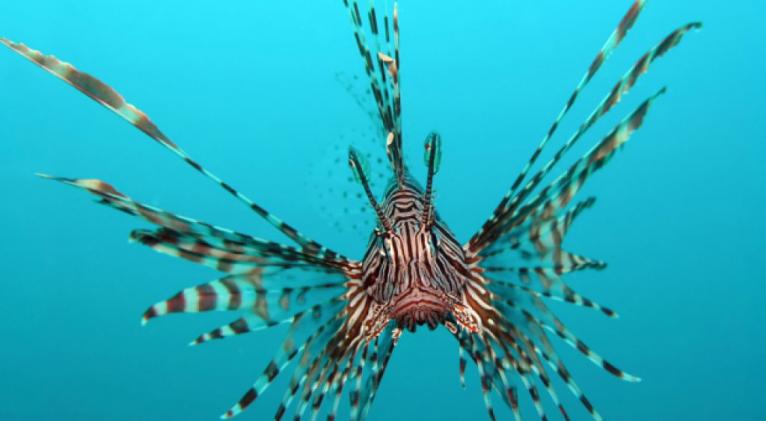To stop invasive lionfish, divers are helping sharks acquire a taste for them
especiales

In the war against invasive lionfish, Andres Jimenez took up one of the oldest weapons used by humans: the spear.
Jimenez thought this was a novel approach to help rid the Caribbean Ocean of a growing menace. He skewers the colorful fish into a kabob, swims to coral in a marine sanctuary off the coast of Cuba and holds it bleeding and squirming under the jaws of reef sharks.
The idea is to get sharks to develop a taste for a fish they are not accustomed to eating. That’s right, Jimenez, who co-manages a dive operation in the Gardens of the Queen National Marine Park, is trying to teach one of the Caribbean’s biggest predators to eat a new type of fish.
The lionfish is an exotic glutton that eats everything it can stuff in its mouth, and the fish are destroying life on the coral reef. Native to the Pacific Ocean, the fish were widely traded for their looks and were first spotted near Miami in the mid-1980s before proliferating in the Gulf of Mexico, the Atlantic and the Caribbean near the turn of the century.
They have been called the Norway rats of the Atlantic and Caribbean because they are voracious eaters that wolf down scores of reef animals from Florida to Mexico and Venezuela but have no predator in those waters.
Spoon-feeding sharks, as Jimenez has done in recent weeks, is the latest desperate attempt to restore the balance of an ecosystem that humans threw out of whack.
Reef sharks are thought to be one of a few animals that can choke down a lionfish. To avoid the toxic spikes on its back and tail fin, said Antonio Busiello, they eat the fish starting at its mouth.
Busiello, a photography documentarian in Florence said he watched that happen while diving in Honduras with park officials who speared lionfish and fed them to reef sharks in 2010. His website is full of pictures depicting the action.

But marine ecologist Serena Hackerott and her colleagues at the University of North Carolina at Chapel Hill said feeding lionfish to sharks is crazy. Sharks “are going to associate divers with food,” she said.
In a test of 71 ocean sites — in Mexico, Belize, Honduras, Cuba and the Bahamas — UNC researchers found nothing to show that lionfish are shark bait, according to a paper published last year in the journal PLOS One.
“I’ve been a diver for more than 10 years and have never felt threatened by a shark,” Hackerott wrote in a recent blog post. “I might not feel so comfortable, though, if sharks began to expect snacks every time I enter the water.”
It’s a justifiable fear that often plays out at the sanctuary, Jimenez said. In an email from Cuba, he wrote that “sharks don’t seem to be hunting for lionfish naturally, but they are really mad for dead or injured lionfish, and they get used to being fed lionfish by divers. They learn fast and improve ways to get that lionfish once the diver captures it.”
When Jimenez dives with groups of divers and photographers, the sight-seeing can become tense and dangerous.
For example, he wrote, “An injured lionfish escapes the sharks and then the sharks get really mad. They start looking for the prey everywhere, and in this quest they . . . sometimes hit divers with the nose, or can even try to bite the spear, the rocks where the lionfish is hiding, or the cameras. Then the situation sometimes gets out of control.”
I might not feel so comfortable, though, if sharks began to expect snacks every time I enter the water
Busiello could testify to this behavior. When he traveled to Roatan Marine Park in Honduras four years ago to see thousands of grouper in a mating ritual and “missed the moment,” he wound up diving to watch lionfish get fed to the park’s 22 gray reef sharks.
The sharks came close — 15 inches from his camera. “I got bumped a couple of times. They hit me on the side,” Busiello said. “A big shark, a six- to seven-foot shark hits you, you feel it.”
Somehow the recommended approach to reducing lionfish was twisted around, Hackerott said: They should be overfished for human consumption, not reef sharks. The pretty fish is poisonous, but when a chef rips out its spine and cooks it, lionfish are delicious.
There’s no witness to an instance of someone releasing lionfish into the waters in Florida, but that’s the largely agreed upon working theory for how they ended up there.

This sort of thing keeps happening in the United States, the second largest market for the legal trade of wildlife. Florida in particular is overrun with Burmese pythons, tegu lizards from South America and Cuban tree frogs to name only a few invasive animals.
The Chesapeake Bay region is fighting the aggressive Asian northern snakehead fish that eats native fish, and efforts to harvest it from rivers have done little to stop it. Asian carp that spread from Arkansas to the Great Lakes region and Louisiana have out-muscled native fish for food, leaving many to starve.
The voracious appetite of lionfish is why divers and marine biologists want to eliminate them, but feeding them to sharks is a scary task, Jimenez said. “I am [spearing them] very seldom, as it gets dangerous,” he said. “You can’t do it in all spots, only in places with small shark populations.”
Teaching sharks to eat lionfish “is a double-edged sword,” said Ian Drysdale, the Honduras coordinator for the Healthy Reefs Initiative. “You don’t want to relate human divers with shark feed. It can get out of hand.”













Add new comment